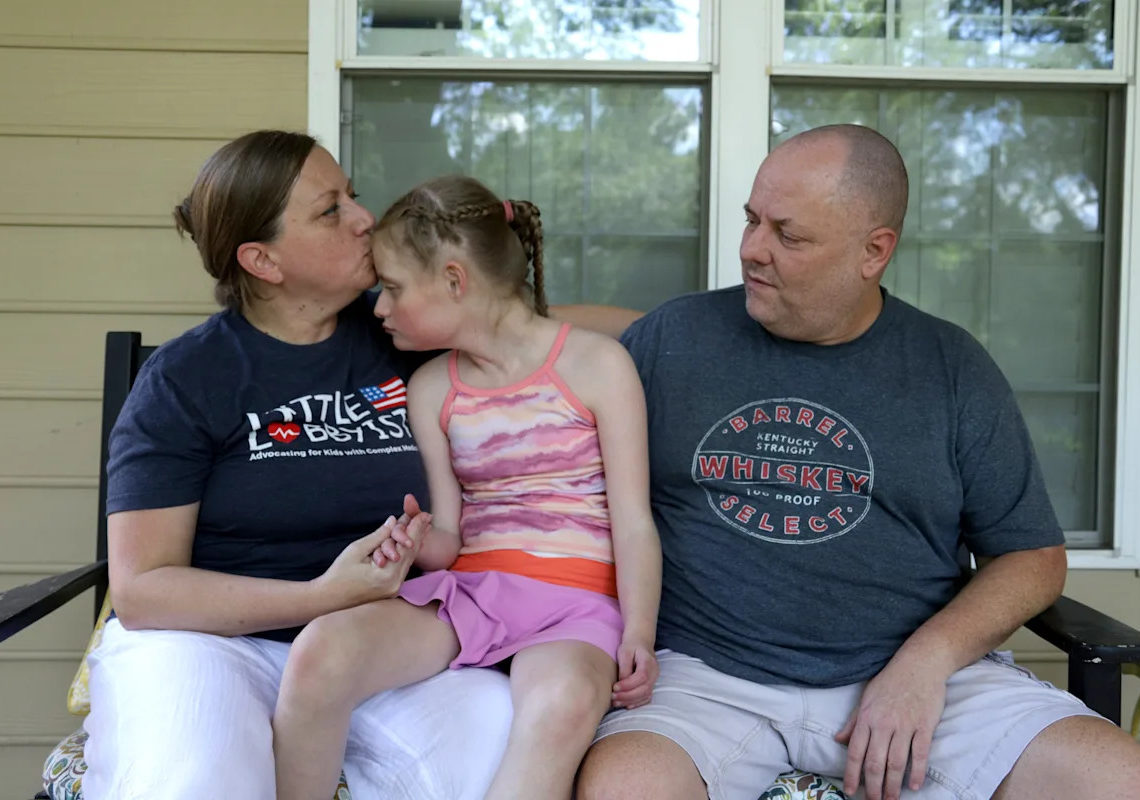Stacy Staggs’s 11-year-old daughter will never eat or breathe on her own.
Five times a day, Staggs or a nurse feeds her daughter, Emma Staggs, doctor-prescribed formula through a feeding tube at home. The formula comes at $25 per bottle, amounting to $125 per day.
The formula is covered through Medicaid, a program jointly funded by the federal government and states, which faces severe cuts through President Donald Trump‘s Republican-backed and recently passed reconciliation package. The law directly impacts nondisabled adults who must get a job or qualify for an exemption in order to maintain Medicaid coverage. But advocates are worried about how vulnerable populations might be harmed as states manage funding shortfalls due to other provisions in the law.
Emma Staggs has bilateral vocal cord paralysis that prohibits her from swallowing or sounding out words, chronic lung disease, developmental delays and other daily health struggles. She survived the first months of her life in the intensive care unit after she was born at 1 pound, 9 ounces. In addition to the formula she needs to survive, Medicaid covers a pulse oximeter, oxygen concentrator, oxygen tanks for travel and a heap of other medical equipment in her North Carolina bedroom.
The program also pays for in-home health nurses who help her eat and breathe and occupational therapy at a farm that helps her gain strength and dexterity to be able to use her hands. It covered horseback-riding physical therapy that helped her climb stairs this year.
The Staggs are on edge. For them, it’s no question that the new law could put their ability to cover the cost of their daughter’s care in jeopardy. The law slashes the amount of federal money given to states to fund their Medicaid programs, so now states will have to decide which programs to cut.
The North Carolina program that funds Emma Staggs’s formula, medical equipment, health nurses and occupational therapy is called the Katie Beckett waiver or the Community Alternatives Program for Children. It’s a Medicaid waiver that helps families of children who have complex needs and long-term disabilities receive and sustain at-home care so their children do not need to be cared for in an institution.
Stacy Staggs is worried that it could end up on the chopping block.
“We would have to take out loans, sell the house and move in with my mom,” Staggs said. “We would go into medical bankruptcy to keep Emma alive.”
Officials from North Carolina’s Department of Health and Human Services have not said whether the waiver will be cut due to reduced Medicaid revenue. James Werner, a spokesperson for the department, said in an email to USA TODAY officials are “reviewing the final legislation to determine its full impact on the state and its residents.”
“These cuts not only impact the people that rely on them directly but also strain the systems and communities that hold us all together,” Werner said.
Millions of children and adults with disabilities enrolled in Medicaid rely on the medications, equipment and staff the program covers to stay healthy, survive and be active members in their communities. Without in-home help, and sometimes even with it, family caregivers − frequently mothers − often pick up the slack, switching jobs or leaving their careers behind to care for their kids with special needs. The cuts to Medicaid could exacerbate that reality.
For the Staggs family, it’s a matter of life and death.
“If we get to a place where we’re no longer eligible, I can start a timer on how much longer Emma will be alive,” Stacy Staggs said. “That’s the end of it. It’s not abstract. It’s not hyperbole. It’s the only thing that she can eat. There isn’t any substitute.”
What is Medicaid, who uses it and what’s changed?
Some states have opted to expand Medicaid to help families pay for items their children with disabilities need that other health insurance companies might not cover, like wheelchairs, car seats and communication devices.
There’s no other program that comes close to the support Medicaid provides for recipients and their families, said Sara Rosenbaum, a professor of health law and policy at George Washington University’s Milken Institute School of Public Health.
“There’s no health system recovery from a destroyed Medicaid program,” Rosenbaum said.
How Trump’s tax bill Could cut Medicaid for millions of Americans
Nearly half of the 78 million people who were enrolled in Medicaid and Children’s Health Insurance Programs at the start of the year were children, according to the federal government.
One in 5 children in the United States has special health care needs, and about half of those kids have coverage through Medicaid or the Children’s Health Insurance Program, according to Georgetown University’s McCourt School of Public Policy Center for Children and Families.
The Trump administration’s Medicaid cuts will leave nearly 12 million people uninsured by 2034, according to a cost estimate from the Congressional Budget Office. Another estimate from the Senate Joint Economic Committee Minority says it’s closer to 20 million people.
The new law increases Medicaid eligibility checks from once a year to twice a year, leading to more paperwork and potentially delayed funding for already overwhelmed families like the Staggs. This goes into effect on Jan. 1, 2027.
States with robust Medicaid expansion programs, also known as “optional” enrollments, will also have to roll back supports because they’ll receive less money from the federal government to fund them.
Medicaid’s opponents “just don’t understand the program,” said Kim Musheno, senior director of Medicaid for the disability advocacy group The Arc.
“They just see a price tag,” Rosenbaum said. “And the price tag is for people they consider wholly undesirable.”
‘Attack on rural America’ Kentucky governor hits Medicaid cuts in Trump’s megabill
Supporters of the GOP’s plan, including Speaker Mike Johnson, said the federal government needs to slash funding and that Medicaid needs to be more efficient. He also said able-bodied people who don’t work and undocumented immigrants should be barred from receiving medical assistance in an interview with CBS News in May. Those who don’t work are “taking advantage of the system,” he said.
“What we’re doing is working on fraud, waste and abuse,” Johnson said.
In-home help is essential for caregiver parents
Lindsay Latham, a mother in Virginia, doesn’t want to quit the job she loves as director of operations for a lighting company. But she’ll likely have to if Medicaid cuts strip her 11-year-old son of in-home care.
Her son, Calvin Latham, was born with a brain malformation. Doctors told them he might never walk or talk, and that he’d likely develop epilepsy. He’s progressed a lot since then, Latham said, but he still needs help eating, drinking, bathing and getting dressed.
Latham said she thought their family’s health insurance would cover her son’s medical needs. But it didn’t cover all of it. Medicaid has picked up the rest of the tab to cover things her and her husband’s insurance won’t, including his car seat, an adaptive stroller, a speech device, anticonvulsant medications and in-home attendant care to help him get out of bed and ready for school in the mornings, and bathed and back in bed at night.
It wasn’t easy, Latham said. Her son’s Medicaid application was rejected three times before he was enrolled through the Commonwealth Coordinated Care Plus Waiver. She’s bracing for more red tape with the new requirements that involve more frequent eligibility checks.
“To make it harder for people who are working to fill out paperwork to maintain their medical coverage,” Latham said. “It’s cruel.”
More pressing, Latham is worried the state will reduce or cut her son’s attendant and respite care if the reduced federal match can’t support the hours he needs. The state’s Medicaid budget is already strapped, she said, and her son receives minimal hours through his Medicaid wavier.
Her son is on a waitlist for the state’s Developmental Disability Community Living Waiver, also funded through Medicaid, which provides in-home care. It’s a long list, she said, and she’s been told he might not get off it until he’s 30. She’s terrified the state will cut or shrink the program even more.
“This isn’t just an immediate effect on Calvin’s life,” she said. “This is going to be lifelong.”
Virginia Gov. Glenn Youngkin’s office did not respond to USA TODAY’s inquiry about what programs will be eliminated or reduced due to the federal Medicaid cuts.
If Medicaid no longer covers her son’s attendant care, especially during the summer months when he’s out of school, Latham said all of his caregiving duties will fall to her and she’d become a stay-at-home mom. As the breadwinner of the family, she said, that would mean the Lathams won’t be able to afford updating their home as their son grows up and starts to need a wheelchair and wheelchair-accessible entryways.
“We’re not on this because we’re trying to play the system,” Latham said. “We’re on it because we need it. He needs it. He deserves to have a fulfilling, rich life in his community.”
‘Really a lot at stake’
Doctors told Mary Caruso the chances of her having a child with Friedreich’s ataxia, a rare genetic disorder that affects the nervous system, were 25%.
She didn’t have one child with the disease. She had two.
“We do play lotto,” Caruso joked.
Thirty years later, Caruso said her family has finally settled into a routine that includes a rotation of more than a dozen health attendants covered through Connecticut’s Community First Choice program, a Medicaid expansion program through the Affordable Care Act. Both of her children − 35-year-old Alexandria Bode and 38-year-old Sam Bode − have jobs and spend time volunteering and participating in various community events with the help of their staff.
“We have some amazing people here,” Caruso said. “I don’t know, honestly, what we would do without them.”
Connecticut Gov. Ned Lamont’s office did not respond to USA TODAY’s inquiry on whether the state will cut or reduce services for those enrolled in the Community First Choice program. If the state opts to reduce expansion programs because of federal Medicaid cuts, and the Bode siblings lose coverage, Caruso said they’ll have to leave their jobs.
It would fall to Caruso to help them eat, drink, bathe, dress and perform most other daily activities.
“It’s hard to really understand how valuable caregivers and these programs are. And you’re talking about two people who want to be part of society,” Caruso said. “They have a right to be, and they can’t do it alone, physically.”
There is “really a lot at stake,” Caruso said. She won’t consider ever putting her children in a facility. She’d care for them herself until she died.
“But it would not be easy,” she said.
After working to live on her own, ‘Could this mean that I have to move back?’
Other family caregivers who recently found respite might find themselves back in a caregiving role if their adult children are kicked off Medicaid.
James Rothchild said his daughter was diagnosed with autism when she was 3 years old. It was a “lengthy process” for her to get ready to live on her own, he said, and he wasn’t always convinced it would be possible.
But Chloe Rothschild, 32, moved out 2 ½ years ago.
To prepare for the move, Chloe Rothschild said she spent more than 10 years practicing various skills like working with her in-home aide staff, staying alone overnight and cooking and cleaning.
“I worked really hard to get here,” she said. “So, I don’t want to go backward.”
Rothschild said her direct support providers, who are paid through a Medicaid waiver, come by for one to three hours, four to five days a week, to help her cook, clean, shop and organize.
“I’m really thriving,” she said. “And I’m continuing to make progress and gain skills. Like just this weekend, I’m going out of town for work. And for the first time ever, no one is going with me.”
Dan Tierney, deputy director of media relations from Ohio Gov. Mike DeWine’s office, said the state is “still reviewing the bill for potential impacts.”
“But we do not anticipate any major cuts in Ohio as a result of the bill’s passage,” Tierney wrote in an email to USA TODAY.
Rothschild isn’t convinced. If Medicaid cuts reduce her hours of support or cut them entirely, she’s worried it would lead to skill regression and potentially take away her independence. She wonders: “Could this mean that I have to move back in with my family?”
She can’t live on her own without in-home help, her father said.
“It would be fairly devastating,” he said. “It would not be good for our family.”
‘More pressure on families’ Nearly half of US states are on the brink of a caregiving emergency
‘It’s going to be those of us with disabilities’
Emma Staggs will never be able to live independently.
Medicaid has funded nearly $4 million of her life-saving care for nearly 12 years, her mother said. That’s only for a portion of the services she needs to survive. Her father’s private medical insurance pays for the rest.
Staggs said she is furious about what the potential loss of Medicaid could mean for her family and others like them. Their fate is in the hands of the state now.
“The goal of all of this is less people going forward, and it’s going to be those with disabilities and an inability to work in the workforce,” she said. She and her family lobbied in Washington, D.C., in the days before the bill passed. They now plan to target their state lawmakers.
In the meantime, Staggs has attempted to ration the formula she gets by diluting it with water. Sometimes she gives her daughter Gatorade instead. And she’s made an appointment with her daughter’s doctor to see if they can try another feeding option or a backlog supply of the formula while they are guaranteed Medicaid.
“That’s the part that has me in real panic,” Staggs said. “When they’re talking about an end date to Medicaid, it’s like saying how long they’re keeping Emma alive.”
Madeline Mitchell’s role covering women and the caregiving economy at USA TODAY is supported by a partnership with Pivotal Ventures and Journalism Funding Partners. Funders do not provide editorial input.
Reach Madeline at [email protected] and @maddiemitch_ on X.
Contact Kayla Jimenez at [email protected]. Follow her on X at @kaylajjimenez.
This article originally appeared on USA TODAY: Caregiving parents fear for disabled kids’ lives under Medicaid cuts
The post They don’t need Medicaid. But their kids do. appeared first on USA TODAY.



